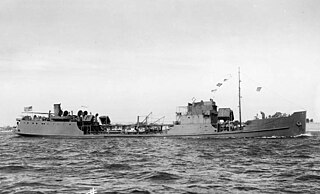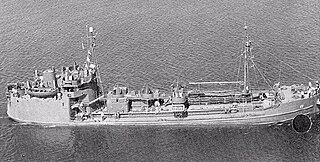
USS Pinnebog (AOG–58) was a Patapsco-class gasoline tanker acquired by the U.S. Navy for the dangerous task of transporting gasoline to warships in the fleet, and to remote Navy stations.

USS Wacissa (AOG-59) was a Patapsco-class gasoline tanker delivered to the United States Navy in 1946. She directly put in reserve and reactivated for service with the Military Sea Transportation Service between 1952 and 1956. In 1957, she was transferred to the United States Air Force. Shortly thereafter she was again transferred to Canada. She was finally scrapped in 1964.

USS Aroostook (AOG-14) was a gasoline tanker acquired by the U.S. Navy for the dangerous task of transporting gasoline to warships in the fleet, and to remote Navy stations.

USS Guyandot (AOG-16) was a gasoline tanker acquired by the U.S. Navy as Veedol No. 2 from Tidewater Oil to serve as a gasoline tanker. The tanker served in Mediterranean operations often under air attack. After postwar decommissioning January 1945 in Algeria and service with the French under lend-lease the tanker was purchased in March 1949 by France serving under the name Lac Noir.
USS Wautauga (AOG-22) was a Mettawee-class gasoline tanker of the United States Navy during World War II.
USS Kalamazoo (AOG-30) was a T1-M-A2 Mettawee-class gasoline tanker acquired by the U.S. Navy for the dangerous task of transporting gasoline to warships in the fleet, and to remote Navy stations.

USS Ponchatoula (AOG-38) was a Mettawee-class gasoline tanker acquired by the U.S. Navy for the dangerous task of transporting gasoline to warships in the fleet, and to remote Navy stations.
USS Towaliga (AOG-42) was a Mettawee-class gasoline tanker acquired by the U.S. Navy for the dangerous task of transporting gasoline to warships in the fleet, and to remote Navy stations.
USS Wakulla (AOG-44) was a Mettawee-class gasoline tanker acquired by the U.S. Navy for the dangerous task of transporting gasoline to warships in the fleet, and to remote Navy stations.
USS Yacona (AOG-45) was a Mettawee-class gasoline tanker acquired by the U.S. Navy for the dangerous task of transporting gasoline to warships in the fleet, and to remote Navy stations.
USS Waupaca (AOG-46) was a Mettawee-class gasoline tanker acquired by the United States Navy for the dangerous task of transporting gasoline to warships in the fleet, and to remote Navy stations.

USS Chewaucan (AOG-50) was a Patapsco-class gasoline tanker in service with the United States Navy from 1945 to 1975. She was then transferred to the Colombian Navy, her final disposition being unknown.

USS Maquoketa (AOG-51) was a Patapsco-class gasoline tanker in service with the United States Navy from 1945 to 1947 and with the Military Sea Transportation Service from 1952 to 1957. She was sold for scrap in 1975.
USNS Rincon (T-AOG-77) was a T1 tanker type, Rincon-class gasoline tanker, in operation for the United States Navy from 1950 through the 1970s. She was originally constructed as MS Tarland for the United States Maritime Commission at the end of World War II, and intended for delivery to the United Kingdom under the terms of Lend-Lease. Completed in October 1945, she was delivered to the Army Transport Service of the United States Army under the name USAT Rincon. Transferred to the U.S. Navy in 1950, she transported gasoline during the Korean War, earning two battle stars in the process. After service extending into the 1970s, the ship was transferred to South Korea in February 1982. As ROKS So Yang (AOG-55), she served the South Korean Navy until the late 1990s, when she was returned to the United States. She was struck from the U.S. Naval Vessel Register on 23 October 1998.

USS Pecatonica (AOG-57) was a Patapsco-class gasoline tanker in service with the United States Navy from 1945 to 1946 and from 1948 to 1961. She was then transferred to the Taiwanese Navy where she served as ROCS Chang Pei (AOG-307/AOG-507) until 2005.

The T1 tanker or T1 are a class of sea worthy small tanker ships used to transport fuel oil before and during World War II, Korean War and Vietnam War. The T1 tanker classification is still in use today. T1 tankers are about 200 to 250 feet in length and are able to sustain a top speed of about 12 knots. The hull designation AO is used by the US Navy to denote the ship is a T1 oil tanker and AOG that the T1 is a gasoline tanker. The small size allows the T1 to enter just about any sea port or to anchor around a small island, this was very useful during the Pacific War. The T1 tanker can carry about 48,000 to 280,000 bbls. Some T1 tankers were used to transport goods other than oil, a few were used for black oil-crude oil, diesel, chemicals and rarely bulk cargo like grain. T1 tankers are also called liquid cargo carriers. The T1 tanker has about a 6,000 to 35,000 deadweight tonnage (DWT) of cargo. The small size also gives the ships short turn around time for repair, cleaning, loading and unloading. A T1 tanker carrying dirty cargo, like crude oil needs a few weeks of labor to clean before carrying clean cargo. Most T1 ships during World War II were named after major oil fields.

USS Klickitat (AOG-64), was the lead ship of the type T1 Klickitat-class gasoline tanker built for the US Navy during World War II. She was named after the Klickitat River, in Washington.
USS Michigamme (AOG-64), was a type T1 Klickitat-class gasoline tanker built for the US Navy during World War II. She was named after the Michigamme River, in Michigan.

USS Peconic (AOG-68), was a type T1 Klickitat-class gasoline tanker built for the US Navy during World War II. She was named after the Peconic River, in New York.
MV Louden was acquired by the Maritime Commission (MARCOM) on a loan charter basis and renamed USS Piscataqua (AOG-70), she was to be a type T1 Klickitat-class gasoline tanker built for the US Navy during World War II. She was named after the Piscataqua River, between New Hampshire and Maine. Piscataqua (AOG-70) was never commissioned into the US Navy.











